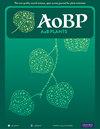Molecular and morphological evidence of hybridization between two dimorphic sympatric species of Fuchsia (Onagraceae)
IF 2.4
3区 生物学
Q2 ECOLOGY
引用次数: 0
Abstract
Hybridization is commonly reported in angiosperms, generally based on morphology, and in few cases confirmed by molecular markers. Fuchsia has a long tradition on ornamental cultivars with different hybrids produced by artificial crosses, so natural hybridization between sympatric Fuchsia species could be common. Natural hybridization between F. microphylla and F. thymifolia was tested using six newly developed microsatellites for F. microphylla in addition to other molecular markers with codominant and maternal inheritance. Geometric morphometrics of leaves and floral structures were also used to identify putative hybrids. Hybrids showed a different degree of genetic admixture between both parental species. Chloroplast DNA (cpDNA) sequences indicated that hybridization occurs in both directions, in fact, some of the hybrids showed new haplotypes for cpDNA and ITS (Internal Transcriber Spacer of nuclear ribosomal RNA genes) sequences. The morphology of hybrid individuals varied between the two parental species, but they could be better identified by their leaves and floral tube. Our study is the first to confirm the hybridization in natural populations of Fuchsia species and suggests that hybridization has probably occurred repeatedly throughout the entire distribution of the species. Phylogeographic analysis of both species will be essential to understand the impact of hybridization throughout their complete distribution.两种二形同栖富贵竹(Onagraceae)之间杂交的分子和形态学证据
在被子植物中,杂交是常见的报道,一般是基于形态学,很少有通过分子标记确认的情况。紫薇在观赏栽培品种方面有着悠久的传统,其不同的杂交种是通过人工杂交产生的,因此同域紫薇物种之间的自然杂交可能很常见。除了其他具有显性遗传和母系遗传的分子标记外,我们还利用新开发的六个微卫星对 F. microphylla 和 F. thymifolia 之间的自然杂交进行了测试。叶片和花结构的几何形态计量学也被用来鉴定可能的杂交种。杂交种与亲本之间表现出不同程度的遗传混杂。叶绿体 DNA(cpDNA)序列表明杂交是双向的,事实上,一些杂交种的 cpDNA 和 ITS(核核糖体 RNA 基因内部转录因子间隔)序列显示出新的单倍型。两个亲本之间的杂交个体形态各异,但可以通过叶片和花被管更好地识别。我们的研究首次证实了紫薇自然种群中的杂交,并表明杂交可能在该物种的整个分布区反复发生。对这两个物种进行系统地理学分析对于了解杂交对其整个分布区的影响至关重要。
本文章由计算机程序翻译,如有差异,请以英文原文为准。
求助全文
约1分钟内获得全文
求助全文
来源期刊

AoB Plants
PLANT SCIENCES-
CiteScore
4.80
自引率
0.00%
发文量
54
审稿时长
20 weeks
期刊介绍:
AoB PLANTS is an open-access, online journal that has been publishing peer-reviewed articles since 2010, with an emphasis on all aspects of environmental and evolutionary plant biology. Published by Oxford University Press, this journal is dedicated to rapid publication of research articles, reviews, commentaries and short communications. The taxonomic scope of the journal spans the full gamut of vascular and non-vascular plants, as well as other taxa that impact these organisms. AoB PLANTS provides a fast-track pathway for publishing high-quality research in an open-access environment, where papers are available online to anyone, anywhere free of charge.
 求助内容:
求助内容: 应助结果提醒方式:
应助结果提醒方式:


